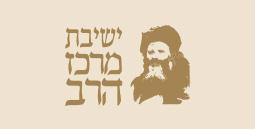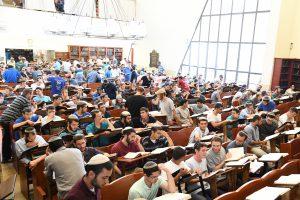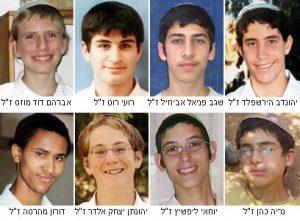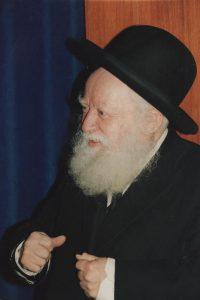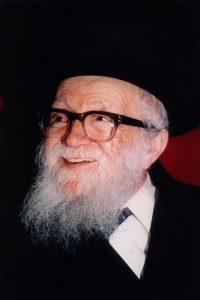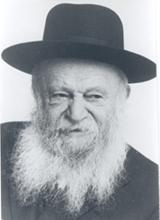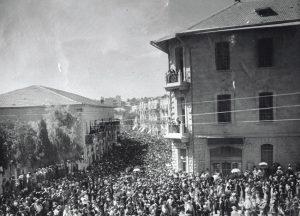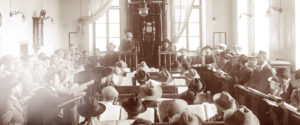Yeshivat Mercaz Harav, “The Mother of Zionistic Yeshivot,” is the very first Zionist Yeshiva, and the ‘flagship’ for the ‘Dati Leumi’ (National Religious) community. The yeshiva is made up of hundreds of students and thousands of its alumni function as Rabbis, Dayyanim, teachers, military officers, and scholars and are all deeply involved in public affairs. Numerous yeshivot, learning institutions and yishuvim (settlements) have been established throughout the years by alumni and the numbers continue to grow every year. The vast impact of the yeshiva’s alumni on the ‘Dati Leumi’ community and on the Israeli society as a whole, transformed the yeshiva into a wider movement representing the ‘Dati Leumi’ community and fulfilling the vision of its founder- HaRav Avraham Yitzchak HaKohen Kook, of righteous memory.
Today, Yeshivat “Mercaz HaRav” is one of the largest Torah centers in Israel. The yeshiva numbers over 600 students and senior scholars. The yeshiva is located in the “Kiryat Moshe” neighbourhood in Jerusalem and its affiliate, “Beit Medrash Nechamat Rachel”, in Kever Rachel. The Yeshiva’s rabbinical faculty numbers over twenty senior Rabbis, all former students of the Yeshiva. Additionally, the Yeshiva operates a halachic department, “Beit Avraham”, which decides halacha for the wider community in all areas of Torah. Likewise, the “Halacha Berura” institute operates inside the Yeshiva wherein approximately thirty Rabbis deal with Halachic clarification as well as the publishing of the writings of HaRav Kook. Similarly, the ‘HaRav Tzvi Yehuda institute’ deals with the publishing of the philosophical letters of HaRav Kook as well as those of his son HaRav Tzvi Yehuda.
The Yeshiva under HaRav Yaakov Moshe Charlap:
HaRav Yaakov Moshe Charlap, the Rav of the “Shaarei Chesed” neighbourhood in Jerusalem and the “איש ברית קדשו” primary student of HaRav Kook began his tenure as Rosh HaYeshiva already during the lifetime of HaRav Kook and continued in this capacity long after his passing. HaRav Charlap’s worrying state of health added to the Yeshiva’s already difficult general state in this period, regardless, a trying period for the entire Jewish community in Israel due to Arab harassment and a poor economic situation. In 1943 a group of students from various kibbutzim as well as from the agricultural school “Mikve Yisrael” arrived at the Yeshiva. These students felt that the spiritual situation in the Yeshiva needed strengthening. Consequently, special ‘shiurim’ were organised for these students in which the practical laws pertaining to the Land of Israel were taught. Thus these students are remembered for strengthening the Yeshiva through their youthful and dynamic energy and their pioneering spirit. In 1946, at the request of HaRav Tzvi Yehuda Kook, HaRav Avraham Shapira, later Rosh HaYeshiva as well as Chief Rabbi of the State of Israel, joined the Yeshiva staff. In 1948, with the outbreak of the War of Independence, many of the Yeshiva’s students and staff were conscripted into the “Hagana”. Many of the students did not return to the Yeshiva after the war and, consequently, the light of the Yeshiva appeared bleaker than ever before.
Baruch Hashem, in May 1948, the State of Israel was established. Eight years previously, HaRav Moshe Tzvi Neria, an alumnus of the Yeshiva, founded a yeshiva-high school in Kfar HaRoeh, the first of the “Bnei Akiva Yeshiva-High Schools”. With the war being on the mind of the country in its early years the strengthening of identity was of utmost importance. Roughly a year after the founding of the State a small group of Kfar HaRoeh alumni established a new Yeshiva known as “Mishkan Yisrael” headed by HaRav Yaakov Kalev , a former student of the “Harry Fischel Institute for Talmudic Research” and the senior teacher at the “Bnei Akiva Yeshiva-High School”. Due to financial and organisational difficulties the students of the new Yeshiva decided, together with its teaching staff, to merge with “The Central Yeshiva”, “Mercaz HaRav”. This process infused the Yeshiva with young blood and caused new classes to be given in the Yeshiva.
On December 6, 1951 HaRav Yaakov Moshe Charlap passed away. Shortly before, after HaRav Charlap took ill for the final time, HaRav Avraham Shapira began to deliver the general discourse in the Yeshiva.
The Yeshiva under HaRav Tzvi Yehuda Kook:
With the passing of HaRav Charlap, HaRav Tzvi Yehuda Kook, the son of HaRav Avraham Kook began to function as Rosh HaYeshiva. Approximately two years into his tenure, members of “Gachelet” or a “nucleus of pioneers in Torah learning” who were part of the Bnei Akiva tribe “Eitanim” arrived at the Yeshiva. They made a decisive contribution to the status, in the eyes of the community, of the Yeshiva and of the legacy of HaRav Kook. These youths were imbued with a vision and with a passion for the Land of Israel and, thus, had a tremendous influence over fellow Bnei Akiva members. In HaRav Tzvi Yehuda they saw a teacher and a leader and through this they became a more dominant force in the teaching staff and among the youth of religious Zionism in general. In 1959 HaRav Tzvi Yehuda turned to HaRav Shaul Yisraeli and requested that he deliver a general discourse in the yeshiva, in addition to the general discourse being delivered at the time by HaRav Avraham Shapira. Even with his busy schedule and after he had just served a long term as rabbi of the Kfar HaRoeh moshav in Emek Hafer, HaRav Yisraeli agreed to accept what would be a life-long responsibility.
Baruch Hashem, in September 1960 the foundation stone of the new yeshiva building was laid and in September 1964 the “Central Yeshiva” began learning in its new building in the “Kiryat Moshe” neighbourhood in Jerusalem. The yeshiva doubled its student number reaching two-hundred students. The “shiur” network expanded to include shiurim in: “emunah” by HaRav Tzvi Yehuda, “Orot HaKodesh” by HaRav David Cohen (The Nazir), talmud by HaRav Mordechai Frome, “Tanakh” by HaRav Yehoshua Bachrach, “Mussar” by HaRav Natan Ra’anan who served as administrator of the yeshiva. Additionally, general discourses were delivered by HaRav Avraham Shapira and HaRav Shaul Yisraeli. The shiur of HaRav Tzvi Yehuda spanned a wide range of subjects; but it was in his Saturday night “parsha” shiur that his full prowess was revealed. The aim of the shiur was to observe the overall trend that was evident throughout the weekly Torah portions. HaRav Tzvi Yehuda concentrated on central ideas which he believed were fundamental principles in shaping the world of the yeshiva student. A significant component of the educational influence of HaRav Tzvi Yehuda was the personal example. This is borne out by the many books and memoirs about him which emphasize the personal, experiential aspect of his teaching. During this period, there was a great deal of involvement of yeshiva students in the state and various issues on the public agenda. In 1964, over one hundred yeshiva students participated in a demonstration against the mission on Haneviim Street in Jerusalem. As a result of this activity, which aroused great enthusiasm and protests in various countries abroad, some of the yeshiva students were arrested. Three years later another demonstration was held against a Christian music concert in which Christian works were played by Richard Wagner, who was a prominent anti-Semitic composer. The yeshiva students entered the concert and began to sing different songs. Every few minutes a different group got up and left the hall and in the end thirty-nine men from the yeshiva were arrested. This protest aroused a stormy public debate, following which the yeshiva students sent a clarification letter to the newspapers, stating that a concert of this kind was akin to spitting on the memory of millions of martyrs of our people who were killed on the basis of the contents of the concert.
During this period, a connection was established between the yeshiva and Kibbutz Tzora, near the city of Beit Shemesh. This connection brought members of different kibbutzim and young people seeking a way to contact the yeshiva. On “Yom Ha’atzmaut”, the 5th of Iyar 5727 (1967), about three weeks before the outbreak of the Six-Day War HaRav Tzvi Yehudag delivered a sermon which, for generations, will be remembered among the yeshiva students as a vision of “Ruach HaKodesh.” On this day, a festive meal was held in honor of the 19th anniversary of the establishment of the state. In his sermon, he mentioned the feelings experienced on the 29th of November 1947, the day in which the United Nations General Assembly decided to end the British Mandate in Palestine and to establish two independent states in the Land of Israel, a Jewish state and an Arab state (the Partition Plan). He said as follows: Nineteen years ago, on that famous night, when the news of the decision of the rulers of the world to re-establish the State of Israel reached the land, when the entire nation was rushing to celebrate its joy, I could not go out and participate in the festivities.
The founding of the Yeshiva:
The Mercaz HaRav Yeshiva was founded by Rabbi Avraham Yitzchak HaCohen Kook, the first Ashkenazi chief rabbi of the Land of Israel, in the summer of 1923. The dream of establishing a yeshiva in Jerusalem accompanied the rabbi even when he was young. Even when he served as the rabbi of Jaffa and the moshavot (1904-1914), the dream of setting up a yeshiva, perhaps in Jerusalem, began to take shape. After World War I, in 1919, he was appointed rabbi of Jerusalem and was later chosen to serve as the first Ashkenazic chief rabbi of the Land of Israel (1904-1935). As part of his job he wanted to establish a movement called “Degel Yerushalayim” or “The Jerusalem Flag”, one of whose main tasks was to establish a yeshiva that would serve as a focus for halakhic and ideological discussions. Meeting the rabbi’s vision was a national goal of the highest order.
The first sparks of the establishment of the yeshiva began with a small circle of yeshiva students from Jerusalem who gathered together to hear shiurim in Jewish law and aggadah from Rabbi Kook. At the very beginning of the yeshiva, the rabbi knew that it would not be a yeshiva like any other and he outlined three main goals, which, implemented together create “a life of creativity”:
A. Training young scholars who can be significant spiritual forces and influence the course of the Jewish people in the Land of Israel.
B. The development of Torah works that will combine the theoretical dimension with the systematic dimension in arranging lectures.
C. Merkaz HaRav will serve as a preparation for the foundation of a “World Central Yeshiva” that will influence “the renewal of our spiritual life … and all our shared national lives which will be renewed in the Holy Land.”
The curriculum and the educational goals in the yeshiva were first written on Chanukkah in 1922 by Rabbi David Cohen (“the Nazir”), primary student and close associate of Rabbi Kook, at the request of his teacher. This plan was very comprehensive and was a bold and far-reaching innovation in the yeshiva world of the Old Yishuv. This innovation is expressed both in the extent of the knowledge required of the yeshiva students in the fields of the “Revealed Torah (Talmud, Mishpat) and the”Hidden Torah” (study of Kabbalah), as well as in the study of Tanach, dealing with biblical criticism and deep understanding of Jewish thought throughout the ages.
Rabbi Avraham Aharon Borstein, the “Gaon of Travig”, who immigrated to Israel in 1924, was appointed Rosh Yeshiva alongside Rabbi Kook. Many of the Talmudic scholars in Jerusalem, including those who were not connected to the yeshiva, attended his classes. He died two years later, in 1926. During this period there were calls for the invitation of Rabbi Shimon Shkop to serve as one of the teaching staff at the yeshiva, but in the end it did not come to fruition. There is also a letter in which Rabbi Yechezkel Abramsky, while in London, sought to serve as a teacher in the Yeshiva.
The recruitment of students to the yeshiva was done by public advertising through proclamations, pamphlets and personal conversations that were adapted to the generation, the recommendations of Rabbi Kook for obtaining entry visas to the Land of Israel from the Mandatory British government and the charismatic influence of Rabbi Kook. The students’ religious and biographical backgrounds were, in some cases, very different. Some of the students were graduates of famous yeshivas in Russia, Poland and other countries, and had seen the full scope of Torah learning, but some of the students arrived with only a basic background.
Rabbi Kook’s positive attitude towards the Jewish settlement of the Land of Israel, his “Dati-Leumi” outlook and his close relations with the secular public greatly influenced some yeshiva students to participate actively in the Haganah and the underground organizations, and some became key figures in these organizations, the most famous being David Raziel, commander of the Irgun.. Indeed, significant mobilization followed the events of 1929 (The Chevron Massacre)..
As part of the national activity through which the yeshiva students were educated, the Bnei Akiva youth movement was established by one of the yeshiva students.
On Rosh Chodesh Cheshvan (1929), Rabbi Kook founded the Merkaz Harav “Mechina”. The Mechina was designed to train students at the age of 14-18 to later study at the Yeshiva, and was called the Yeshivat Torat Yerushalayim. This preparatory program served as an important foundation for the “Yashlatz” high school, which was later established next to Yeshivat Mercaz HaRav.
In 1933 Rabbi Kook established the Harry Fischel Institute for Talmudic Research in order to provide a response to the Biblical criticism of the Hebrew University through critical study that is done out of respect and holiness.
On the 3rd of Elul 5655 (1935), a long chapter in the history of the Yeshiva and the Jewish people ended with the passing of Rabbi Avraham Yitzchak HaKohen Kook. A deep sorrow accompanied the yeshiva students, but along with it was a sense of mission and a desire to realize the great dream that Rabbi Kook envisioned.


